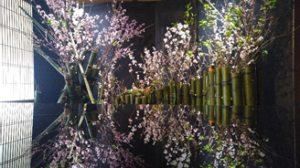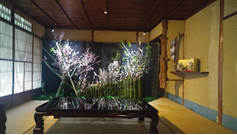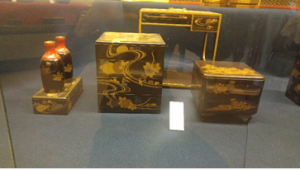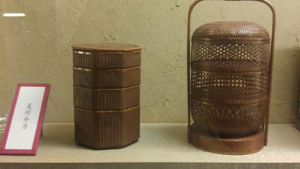F.NO.1:Kyoto Phenology Calendar April 2022 Issue
From this April, every Thursday, we will post a blog about how to enjoy Kyoto and the Kyoto Phenology Calendar. Enjoy the nature and seasons of Kyoto, and dig deep into the festivals and events rooted in daily life and the uniqueness of Kyoto. We will show you how to enjoy the seasons and how to enjoy Kyoto related to it. Let’s enjoy Kyoto with everyone. Best regard.
Yoshie Doi
Sakura
Spring in Kyoto Enjoying cherry blossoms
On March 24, the Kyoto Meteorological Observatory declared that the cherry blossoms would bloom, and at the beginning of April, the cherry blossoms would bloom for seven minutes. It’s finally spring.
Sakura, which is in full bloom in April, we, who live in Japan, enjoy cherry blossoms every year. I have heard from the French that “the best luxury is to enjoy Japanese cherry blossoms in April and British roses in May.”
This photo shows 50 cherry blossoms in a bamboo tube in the tatami room of Arashiyama Yusai-tei. 50 pieces are reflected on the painted desk and become 100 pieces.
 |
 |
Hundred cherry blossoms in the tatami room (Arashiyama Yusai-tei, Yasunari Kawabata’s room) Photographed March 29, 2022
We can’t smell the spring when we wear a mask, but let’s enjoy the sounds of the river and mountains of the Oigawa River, love the cherry blossoms, and enjoy the cherry blossom viewing lunch box. This Arashiyama Yusai-tei is also the room where Yasunari Kawabata wrote “Yamanooto : The Sound of the Mountain”. The former cooking inn “Chidori” is now Arashiyam Yusai-tei.
I have heard the sounds of mountains and rivers many times. Make a finely honed sensitivity of your five senses and enjoy yourself, an 8-minute walk from the Oigawa River, upstream along the Katsura River. It is in the mansion of a dyeing artist. It will be a new attraction in Arashiyama.
Enjoy spring and enjoy spring food
Speaking of cherry-blossom viewing, it is a cherry-blossom viewing dumpling and a cherry-blossom viewing lunch, as symbolized by “Hana yori Dango : Do not understand elegant”. In Kyoto, there is the Bento Box Museum, which displays bento boxes from the Edo period.
Do not understand the wind flow
 |
 |
Hanbeifu Main Store (Kamogawa Gojo Ohashi Higashi) 2nd floor Bento Bako Museum (scheduled to be reopened this fall)
The Hanami bento in the Edo period is a Jubako-lunch box called “Sageju,” which incorporates not only dishes but also tableware and sake sets, and was often used in the Edo period. You can carry it in your hand.
The contents of the Jubako vary, but it seems that the gorgeous Bento box included kamaboko, omelet, yakimono, sashimi, and kinton in the Edo period “Ryorihayashinan : Cooking text books.”
 |
“Cooking Guidance Book” Sageju
 |
“Cooking Guidance Book” Cherry-blossom viewing Sageju

Exhibits at the Bento Box Museum Cherry-blossom viewing Sageju
 |
Exhibits at the Bento Box Museum Summer Sageju
 |
Yao Sada’s special bamboo basket set. Sake is Matsui Sake Brewery, Shinzo Junmai Gomon Shinzo KAGURA, unfiltered raw Sake (clear, Kyoto’s love yeast) made with yeast called “Kyoto no Koi”.
The pottery is the work of Mizuho Nishizawa in Unrakugama.
 |
Three-color dumplings and matcha Shioyoshiken
Why did the cherry blossom viewing flowers change from plum blossoms to cherry blossoms?
In ancient China, plum blossoms were a staple of cherry blossom viewing, and in the Nara period, plum blossoms were a staple of cherry blossom viewing in Japan. This is the opinion of Sugawara no Michizane in Kanpyo 6 (894), and due to the influence of the abolition of the envoy to Tang, the plum blossoms will change to cherry blossom viewing. The cherry blossoms that bloom all at once and scatter all at once have flowers that bloom downward. In addition, cherry blossoms were a flower that informs the seasons for farmers by informing them of the making of seedlings.
Konohanasakuyahime
In “Kojiki” and “Nihon Shoki”, it is described as Konohanasakuyahime, and the cherry blossoms that bloom beautifully in Noyama were originally called “Sakuya”. It seems that it was transformed into Sakura.
In “Manyoshu”, there are Japanese poemns like 41 cherry blossoms, 140 Hagi, 118 plum blossoms, and it is thought that plum blossoms captured the hearts of the people at that time. It is said that the culture of enjoying flowers as an aesthetic appreciation was introduced from China, and it was around the time when Emperor Saga watched the cherry blossoms at Shinsen-en in Konin 3 (812).
At this time, there was a statement in the “Nihon Shoki” that the writers were made to write poetry, and the protagonist of cherry blossom viewing changed from plum blossoms to cherry blossoms.
It is thought that the culture of cherry blossoms has become familiar to the hearts of Japanese people because the plums on the left and right of Shishinden Hall, which is the main hall of the inner lining, have been replanted with cherry blossoms.
In commemoration of Emperor Saga’s favorite cherry blossoms blooming on the premises of the Gosho, singing and dancing banquets are popular among aristocrats under the cherry blossoms, and a grand cherry blossom viewing is held every year, and this cherry blossom viewing culture is the world. It has become an unprecedented culture unique to Japan.
The words for cherry blossom viewing are not found in English, French, and German. It’s not a hike, it’s go to see the cherry blossoms in English.
Blooming cherry blossoms and falling cherry blossoms
In Japan, which has four seasons during the cherry blossom season, it seems that the cherry blossoms in full bloom are giving a signal to open the door to the new season, freed from the severe cold of winter.
When the cherry blossoms bloom, it is dyed in a pale pink color, and when it scatters, you can feel the warm heart of the cherry blossoms that wrap around white.
During the Heian period, the enjoyment of aristocrats spread to the samurai class during the Kamakura period, and during the Azuchi-Momoyama period, many cherry blossoms were planted at temples and shrines. At that time, many cherry trees were transplanted and a cherry-blossom viewing party was held, and Hideyoshi also designed the garden by calling it Nawabari (territory). The cloned cherry blossoms of the Hideyoshi era will bloom in the spring.
It is said that cherry blossoms were called “Shinin bana : dead person’s flowers” during the Warring States period. There is a legend that if you put the body that died in the battle under the cherry tree, the spirit will float, and it was believed that if you clean the scattered cherry blossoms with a warm heart, the spirit will float further.
People involved in cherry blossoms seem to feel the mysterious power. For example, Taisuke Hamada, a Japanese painter who drew the fusuma paintings of Daigo Sanboin over seven years, said, “It wasn’t drawn by me, but by something. Why did I draw such a huge picture?” It is said that he felt the mysterious power with his whole body.
The color of the cherry blossoms, like the color of the autumn leaves, wraps around with the brilliant glow of the trees. It is also said that the beginning of culture and the use of color were at the same time.
Explore the roots of the legend of cherry blossoms and cherry blossom viewing
In ancient Japan, it was thought to be a precursory phenomenon in which a god who normally lives in the mountains descends from the mountain village and descends to the human village. It was written as “Sa-za” and read as “Sakura”, and it was thought that Sa-za meant the god of the mountains (the god of grains) and played the role of a calendar that taught that it was time to make seedlings when the cherry blossoms were in full bloom.
In ancient times, when people crossed a mountain pass, they joined hands toward the mountain god and prayed and thanked them for their safety. Then, the hand was changed to “Tamuke”, “Tauge” was changed to the word “Touge (pass)”, and it was rude to stand to worship the mountain god, so it is thought that he crouched down and joined hands. The word “Shagamu : squatting” is thought to be a word born from the attitude of worshiping God by transforming “saogam”, and it means offering sake to pray to God. It was customary to have Sake and treats under the cherry blossoms by offering Sake and fish (snacks) to the Sagami under the cherry tree (Sa-za) that Sagami dwells in. Also, since offering is not enough, I have come to sing songs and appreciate dedication dances. The word “play” was called from because the guest seat on lawn grass and was one pier and the common people watched it on the grass on the ground.
Hanami dumplings
In the 3rd year of Keicho (1598), Toyotomi Hideyoshi served Hanami dumplings to 1,300 invited guests at the Hanami party of Daigo Sanboin, which is the root of Hanami dumplings. At that time, the dumplings were usually white dumplings with soy sauce flavor. From the Hideyoshi era to the present, this three-color dumpling has been widely eaten by the common people.
These three colors have various meanings. It is generally pink, white and green. There is a theory that we waited for the thaw and the time when the sprout appeared, but there are various theories, and each can be interpreted. Anyway, it is a staple of Japanese sweets that you get in the spring.
April Event Calendar
| Schedule | Event | Place |
| First Sunday | Waratenjingu-Reisai | Waratenjinngu |
| ↑ | Shinkyu-Festival | Yagi-shrine |
| 10th | Okasai | Hirano-shrine |
| 12th | Minakuchi-Hashusai | Fushimiinari-Shinto shrine |
| Second Sunday | Yasurai-Festival | Imamiya-shrine |
| ↑ | Yoshinotayu-tsuizen-Hanakuyo | Joshou-temple |
| ↑ | Enmusubi-kigan-sakura-festival | Jishi-shrine |
| ↑ | Ho-taiko-Hanami-parade | Daigo-temple |
| 15th and 16th
|
Heianjinngu-festival and Next day featival | Heian-shrine |
| Middle April | Saga-emperor-hoken-flower-festival | Daikakuji-temple |
| 18th | Chinka-festival | Izumo-dai-shrine (Kameoka-city) |
| ↑ | Onikusube | Houshaku-temple |
| 18th and 19th | Mid night nenbutsu in gyki | Chionin |
| Third Saturday | Fugenzo-sakura-evening | Senbon-enmando-injo-temple |
| 29th | Kyokusi-festival | Jonangu |
| 24th | Matsunoo-matsuri-sinnko-festival | Matsuo- Shinto shrine |
| 1st ~ 24th 11th is holiday |
Miyako-odori | Minamiza |
| 2nd ~13th | Kyo-odori | Kyoto Prefectural Center for Arts and Culture |
The end of document
